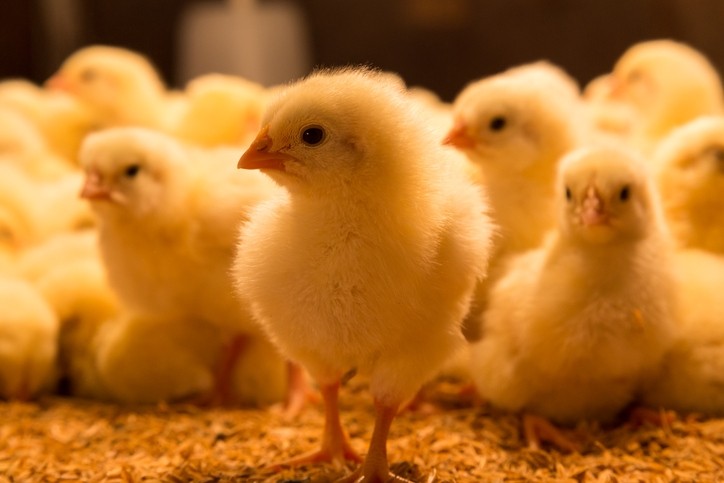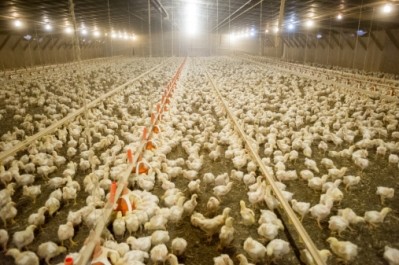Organic acid, essential oil blend may boost chicken efficiency, immune function

An international team of researchers in Canada and China explored the use of a blend of organic acids and an essential oil in the diets of broiler chicken as a potential alternative to using antibiotics. The group members assessed the blend’s influence on growth performance, immune development and digestive functioning.
“The purpose of this experiment was to investigate the effects of feeding blends of sorbic acid, fumaric acid, and thymol (EOA), both on the performance, immunity and the digestive tract functions in broiler chickens,” the researchers said.
The research team found that adding the acid and oil blend during the growing phase improved villus height in the duodenum and jejunum, the researchers said. Adding the mix in the finishing phase of bird development improved crypt depth in the jejunum and ileum and birds getting the feed additive at either stage saw an improved spleen index.
“The present study clearly showed that the addition of EOA mixture during the grower phase increased efficiency, possibly by improving intestinal morphology and increasing digestive enzyme activities of broiler chickens,” they said. “Therefore, the addition of EOA could replace the antibiotic growth promoter in the poultry industry.”
The group members published their work in the journal Animal Nutrition.
Why essential oil, organic acid blend?
The intestinal tract in poultry plays a role in digestion, nutritional uptake and immune function, the researchers said. Poor gut health has been linked to increased production challenges.
However, as many countries have restricted or ended the use of antibiotics in feed, there has been increased interest in finding alternative ways to support gut development and bird health including pre- and probiotics, organic acids and essential oils.
Organic acids can promote growth and have antimicrobial activities and have been linked to a drop in mortality for birds challenged with E. coli, salmonella and coliform, they said. Plant extracts and essential oils also have been of interest for the poultry industry as they may contain compounds including hydrocarbons, phenols, ketones, ethers and esters.
There can be different effects from alternatives based on chemical elements and processing methods, the researchers said. “In recent years, there is a widespread trend to study the complementary effects on growth performance and gut health of substituting antibiotics in the poultry industry,” they added.
However, less is known about the effects or complementary interactions found when combining the use of organic acids and essential oils as a feed additive alternative to antibiotic use for broilers, they said.
Methods and materials
In the feeding trial, 640 broiler chicks were given one of four diets for a period of 42 days, the researchers said.
The diet groups included a corn-soybean meal-based control diet (CON), that diet with 0.15% g/kg enramycin added during the grower period (AG), the control diet with 0.30% g/kg EOA in the grower phase (EG), or the control diet with 0.30% g/kg EOA added in the finisher period (EF), they said.
Feed intake and body weight (BW) were noted on days 21 and 42 and the average daily gain (ADG), average daily feed intake (ADFI) and feed conversion ratios were determined, they said. Mortality also was noted.
On days 21 and 42 the thymus, spleen and bursa of Fabricius were collected from sample birds, the researchers said. Gut samples also were collected for analysis.
Results
Overall, birds getting the blend outperformed those on the control diet in terms of gut development and enzyme activity, the researchers said. ADFI and ADG were similar among diets.
“The results indicate that EOA can be effectively applied in broiler diets, especially during the grower phase by improving intestinal morphology and increasing digestive enzyme activity,” they said.
Birds getting the EOA supplemented diet during the growing period saw an improved feed conversion ratio, higher villus height for the duodenum and jejunum and improved muscular layers in the ileum and duodenum when compared to control group birds, they said. Birds getting the supplement in the finisher period had improved crypt depth in the jejunum and ileum.
Supplementation in the growing stage also increased lipase, trypsin and chymotrypsin activity in the duodenum; trypsin and chymotrypsin in the jejunum and trypsin and chymotrypsin in the ileum, compared to the control diet, they said. Birds supplemented in the finisher stage also had higher levels of immunoglobulin A in the duodenal and ileal mucosa.
Birds getting the blended additive at either growth stage also presented a higher spleen index, the researchers said. “Diet supplementation with EOA increased SIgA levels of the duodenal and ileal mucosa in broilers at d 42,” they added.
“Supplementing EOA during the finisher period improved the immune status of animals, as indicated by an increase in SIgA,” they said. “Nevertheless, it is necessary to study the effects of EOA on intestinal bacteria and bacterial metabolic products to determine mechanisms of action of EOA on performance and the digestive tract functions in broiler chickens.”
Source: Animal Nutrition
Title: Impact of essential oils and organic acids on the growth performance, digestive functions and immunity of broiler chickens
Authors: Xin Yang, Fangyu Long, Hongliang Xin, Chengbo Yang, Xiaojun Yang
DOI: doi.org/10.1016/j.aninu.2018.04.005



















